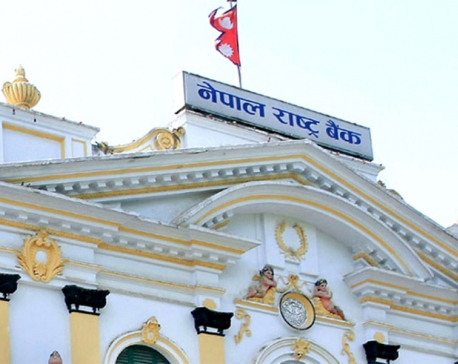
OR
Editorial
NRB must take prudent measures to bring monetary system back on track
Published On: January 11, 2024 07:32 AM NPT By: Republica | @RepublicaNepal

The credit-deposit (CD) ratio of banks and financial institutions (BFIs) have fallen below 80 percent due to a slow increase in lending compared to the excessive rise in deposit collection. According to the records with Nepal Rastra Bank (NRB), the CD Ratio of the BFIs stood at 79.94 percent as of Sunday. The central bank has maintained a ceiling of 90 percent of the CD Ratio for the BFIs to provide loans to their clients. The banks have been lately receiving a good amount of deposits, but are unable to issue loans in the proportionate size due to various reasons. Until the end of the fiscal year 2022/23, several banks were found to have crossed the threshold of the CD Ratio maintained by the NRB. The central bank was then forced to implement a number of measures to ease the liquidity position of the BFIs as there was a severe shortage of loanable funds. But the latest situation where banks are unable to extend loans despite excessive liquidity and are forced to reduce their interest rate does not augur well for the country’s economy.
After an extensive growth in the surplus amount of loanable funds, the BFIs have already reduced their interest rates on fixed deposits to a single digit from over 13 percent. The BFIs are poised to reduce the interest rate further from January 15 as there is a slow demand for loans. Most investors appear to be in a wait and watch mode to take new loans while the banks are focusing on recovering their bad debts rather than facilitating loan issuance. Lately, banks have been facing more challenges to recover increasing bad debts which has been attributed to the economic slowdown at present. As a result, banks’ profit has declined by an average of 28 percent while the return on equity has also gone down to 8 percent from more than 20 percent a decade ago. One of the main reasons why the lending capacity of banks has been affected severely is that they have been struggling to maintain the mandatory capital adequacy ratio mandated by the NRB. The central bank has asked the BFIs to maintain a minimum of 11.5 percent of their risk weighted assets in the capital adequacy fund. The pressure to recover bad debts and payment of unanticipated tax amount to the government for mergers and acquisitions has affected the banks’ capacity to maintain necessary amounts of the capital adequacy fund. In light of this scenario, we believe that NRB has to make some positive interventions, thereby spurring the climate of investment to help reinvigorate the economy that is yet to fully recover from the impacts of the COVID-19 pandemic.
As the banking system has a surplus of loanable funds amid a failure to issue loans proportionate to the size of its deposit collection, the NRB should use its policy tools to ease this situation. A reduction in interest rates is an obvious phenomenon in this situation but the lending rate has not come down by a notable rate, though. If some policy measures are taken to resolve the current stalemate, it could help the economy to gain momentum through an increase in aggregate demand. Balanced money supply and stability in interest rates are crucial for an economy to attain macroeconomic stability. Nepal’s monetary phenomenon has been in a vulnerable situation for almost over a year. The central bank in its capacity as the main regulatory authority to ensure macroeconomic stability in the country should also consider using the qualitative measures to streamline banks in their functioning. The central bank is expected to play a key role to bring the monetary system back on track in light of the current situation.
You May Like This

Banks to open for half a day despite public holiday today
KATHMANDU, Feb 13: Nepal Rastra Bank (NRB) has instructed the banks and financial institutions (BFIs) to operate essential banking services... Read More...

NRB continues with tightened monetary policy through mid-term review
KATHMANDU, Feb 11: Nepal Rastra Bank (NRB) has made provisions for banks and financial institutions (BFIs) to restructure and reschedule... Read More...

NRB to issue repo worth Rs 50 billion
KATHMANDU, Dec 29: Nepal Rastra Bank (NRB) is to issue a repo worth Rs 50 billion for managing liquidity in... Read More...







Just In
- Pesticide residue found in vegetables in Nepalgunj
- Aam Janata Party and Samajwadi Jana Ekata Party merge
- 1,600 participants confirmed for Nepal Investment Summit
- Ilam-2 by-elections held peacefully, vote count likely to start tonight
- NEA schedules five-day power cut across Kathmandu Valley for underground cable installation
- Hundreds of passengers including foreign tourists in distress as poor visibility halts flights to and from PRIA
- Nepal clinches thrilling victory over West Indies 'A' in T20 cricket match
- Capital Market Struggle Committee stages protest demanding protection of domestic investors (Photo Feature)









-1200x560-wm_20240427144118.jpg)

Leave A Comment